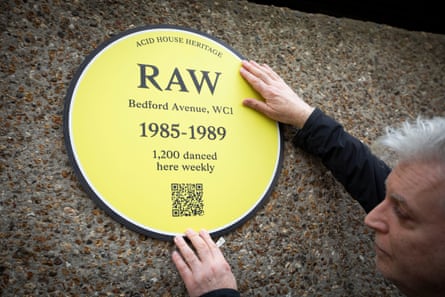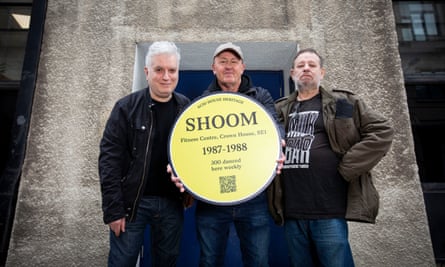‘I remember this street being covered with hundreds of these all over the floor,” says George Georgiou, handing me an original smiley-face flyer he designed for the acid house club night Shoom. “I wish I’d picked them up because now they sell for up to a grand.”
The doorway we’re standing outside in London Bridge is one of many locations we’ll visit today, as Georgiou places acid house heritage plaques outside buildings that were once home to clubs such as Shoom, Raw and Sin. These locations are then tagged on an interactive acid house map on his website. We kick off the day 15 minutes’ walk away on Tooley Street, where the Special Branch club began life in 1984. It was here that resident DJs Nicky Holloway and Pete Tong lured suburban soul boys and Soho trendies to an old pub to get sweaty, while Gilles Peterson kept the footworkers busy by spinning jazz-funk in the other room.
In the 80s and 90s, Georgiou shaped the aesthetic of much of London’s underground dance nightlife. As well as flyers he designed membership cards, logos, posters, banners – entire nightclub aesthetics. “George was instrumental,” says Danny Rampling, who has turned up to see the plaque at the location of Shoom, a club he ran from 1987 to 1990.

Also with us, when not sneaking off to the pub at any available opportunity, is Nicky Holloway, a DJ and promoter who, along with Rampling, was one of the “Ibiza four”. Together with Johnny Walker and Paul Oakenfold, they had their minds melted by hearing DJ Alfredo Fiorito on the island in 1987 – and came back to launch their own club nights. “Obviously you can’t recreate Ibiza in London, but we did bring some of that magic and spirit into the nightlife scene,” Rampling says.
While house music was already pumping loudly in Manchester, Sheffield and Nottingham, such clubs were seismic. “It was indisputably a benchmark for the rave scene,” says Rampling. “People would anticipate all week entering those hallowed doors down into a smoke and strobe-filled basement. It’s not about who was first, it’s about how it was done, and Shoom was a very creative, colourful club.”
That colour saturates the very expensive A5 card I hold in my hand. However, Georgiou was initially nonplussed by the smiley-face design Rampling requested. “I thought it was lame,” says Gerorgiou as we hop in a cab on our way to London’s oldest YMCA club, in whose basement Raw was once located. “It was a 60s thing. It was patches on people’s jeans from Woodstock days. I was like, ‘How do I make this horrible logo more interesting?’”
The answer was with “a cascade of tumbling pill smilies”, as Rampling describes it. The image became synonymous with the burgeoning rave scene and DJ Magazine later called it the best club flyer of all time. “Years later, people would come up to me and shake my hand and be like, ‘I used to make roaches out of that flyer,’” Georgiou says. “Then my work started appearing in books next to people I grew up admiring. Surreal.”
Georgiou was hired to do the decor for entrepreneur Oliver Peyton’s club Raw, which Holloway loved so much he then asked Georgiou to come and make over the pub where he was holding his night Special Branch. “We made a patchwork quilt of banners for every wall,” recalls Holloway. “We covered every inch of this boring looking pub. George turned it into a poptastic pop art venue. I’d take him over Keith Haring any day.”

Georgiou has meticulously archived his work, and a lot of it is about to be turned into NFTs. “This was the first ever flyer for Raw,” he says, handing me a pill capsule that contains a folded-up flyer inside. “Legend has it people were popping these.” He came up with plenty of other unconventional design ideas: “We handed out bananas with stickers on, little cacti, toys, even raw fish – little whitebait in a plastic bag with the club’s name on.”
Holloway and Georgiou worked on many other events together, including Sin at the Astoria, and nights at Holloway’s venue the Milk Bar – locations that are now non-existent, as we walk along a bustling Tottenham Court Road that once housed them – and one-off parties in places including the Natural History Museum. “We put strobes under the dinosaur,” laughs Holloway. “That particular week [in 1987], Walk the Dinosaur by Was (Not Was) was Top 10, so we’re all dancing around the dinosaur to that. We had projections everywhere – it was bonkers. Fast forward 20 years when I was DJing there for some corporate nonsense, and I had to get public liability insurance and do a risk assessment.”
Doing this trail of London’s old rave haunts, the changes to the buildings, and to people’s ability to access such spaces to throw such wild parties, feel very pronounced. “London always has something exciting going on, but it was a pivotal time in youth culture,” reflects Rampling. “Before things got commercialised it was all very DIY and organic. A real feeling of unity, hope, love and optimism.”
At that moment one of the large, bright yellow plaques comes loose from its wall, crashing and spinning down – mirroring the tumbling smiley face on the flyer – and just misses Rampling’s head. “That would have been quite the way to go out, wouldn’t it?” he laughs.
Source: theguardian.com

















